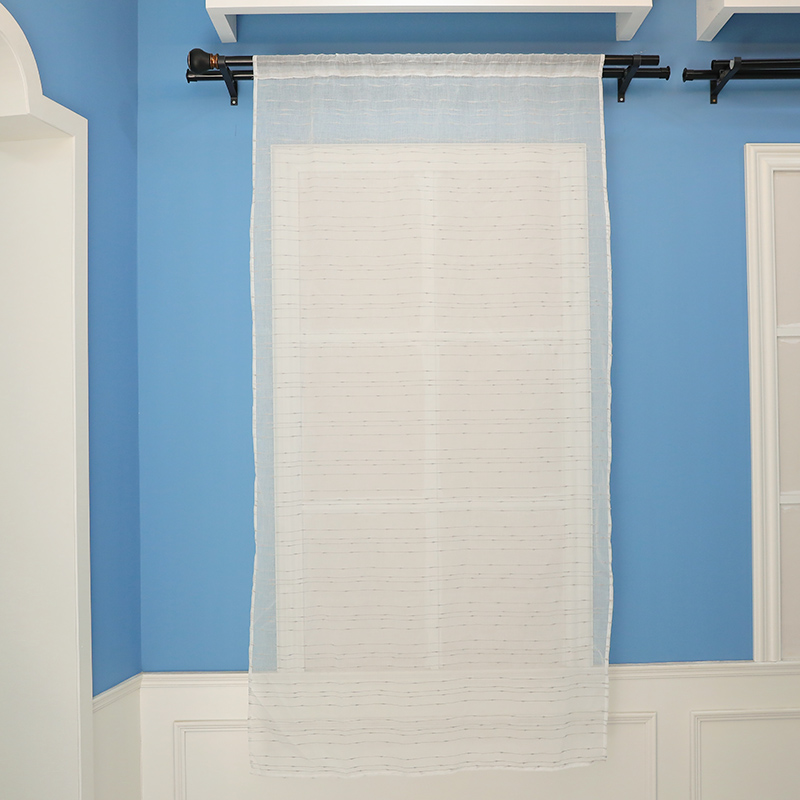Are there any special considerations for installing the rural embroidered sheer curtain in high-humidity environments?
Posted by Admin
In high-humidity environments, it's important to consider the potential effects on the fabric and embroidery of the Rural Embroidered Sheer Curtain. Here are some special considerations for installation:
Fabric Selection and Composition: Optimal fabric selection is pivotal in mitigating the effects of high humidity on curtains. Natural fibers such as cotton and linen offer superior breathability and moisture-wicking properties compared to synthetic counterparts. Cotton, in particular, excels in absorbing excess moisture from the air, thus reducing the risk of mold and mildew formation. Linen, known for its durability and natural resistance to moisture, also proves advantageous in humid environments. These materials facilitate better air circulation around the curtains, discouraging the accumulation of moisture and potential microbial growth.
Ventilation Optimization: Effective ventilation is indispensable for controlling humidity levels and maintaining a conducive environment for curtain longevity. Implementing a multi-faceted approach to ventilation, including the use of exhaust fans, opening windows during non-humid periods, and leveraging air conditioning systems with dehumidifying capabilities, helps mitigate moisture buildup. By facilitating air exchange and promoting airflow, these measures diminish the likelihood of condensation on curtain surfaces, thus preempting the conditions conducive to mold and mildew proliferation.
Routine Maintenance Regimen: Establishing a comprehensive maintenance regimen is paramount for preserving the cleanliness and integrity of curtains in high-humidity environments. Regular dusting or vacuuming of curtains eliminates surface debris and allergens that could exacerbate moisture-related issues. Additionally, adhering to manufacturer-recommended washing instructions, including the use of mild detergents and appropriate water temperatures, aids in removing embedded dirt and maintaining fabric freshness. Periodic laundering, coupled with thorough drying procedures, ensures that curtains remain free from residual moisture that could foster mold growth.
Utilization of Dehumidification Devices: Deploying dehumidifiers strategically complements ventilation efforts by actively removing excess moisture from the air. High-capacity dehumidifiers equipped with humidity sensors and adjustable settings offer precise control over indoor humidity levels, optimizing conditions for curtain preservation. Positioning dehumidifiers in areas prone to moisture accumulation, such as basements, laundry rooms, or bathrooms, targets humidity hotspots and curtails the proliferation of mold and mildew. Regular monitoring of humidity levels enables proactive adjustments to dehumidifier settings, ensuring continuous moisture management and safeguarding curtain integrity.
Preventing Direct Moisture Exposure: Proactively addressing sources of moisture ingress is essential for mitigating the risk of water damage and microbial growth on curtains. Conducting thorough inspections of windows, doors, and structural components identifies potential points of vulnerability, allowing for prompt remediation of leaks or inadequate sealing. Implementing moisture-resistant barriers, such as weather stripping or sealants, fortifies structural integrity and mitigates the infiltration of external moisture. By preemptively safeguarding curtains from direct exposure to moisture, you fortify their resilience against environmental challenges and prolong their service life.
Thorough Drying Protocols: Implementing meticulous drying protocols following curtain laundering is critical for eradicating residual moisture and preventing mold formation. Employing gentle drying methods, such as air-drying in a well-ventilated area or utilizing low-heat settings on a clothes dryer, minimizes thermal stress on delicate fabrics while expediting moisture evaporation. Capitalizing on natural sunlight exposure further enhances drying efficacy, harnessing ultraviolet radiation's disinfectant properties to eradicate microbial contaminants. Rigorous adherence to thorough drying procedures mitigates the risk of residual moisture accumulation and upholds curtain hygiene standards in humid environments.
Simple lines embroidered sheer curtain for home and office

Simple lines embroidered sheer curtain for home and office

One-stop Solutions for All Industries


 English
English Español
Español













